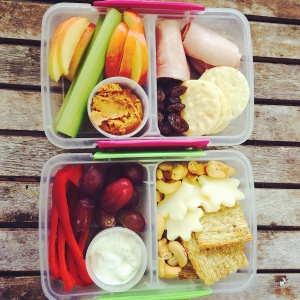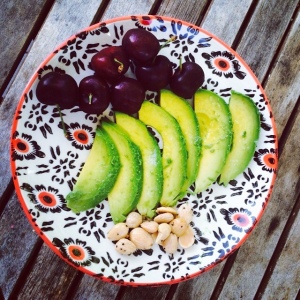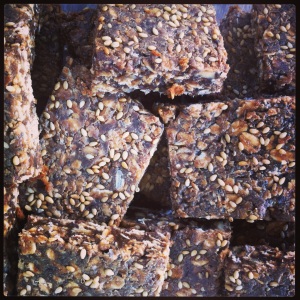
“The real voyage of discovery consists not in seeking new landscapes, but in having new eyes.” ~Marcel Proust
It’s the new year and everyone is suddenly “cleaning up” their act. The list of restrictions and no-no’s add up and SUGAR might be on 2016’s list of banned foods. Taking a hard look at your sugar consumption is always a good idea. Merely shining the light of awareness on an issue automatically changes the situation.
Eliminating sugar cold-turkey is quite difficult; however, making a real attempt at reduction is a worthy use of your intention and effort. If you are one of the few who still aren’t convinced that sugar is harmful, check out this and this and then get back to me when you’ve left the land of denial.
Here are some suggestions for scaling back your intake and reducing sugar cravings as well as a recipe to help you ease into healthier options that include a bit of sugar along with a bunch of healthy other stuff like fiber and healthy fats to balance out your blood sugar.
Get honest about your relationship to sugar. Decide what level of importance you will give to this topic. Maybe it’s just not a priority for you. Maybe other issues in your life require more attention at this time. That’s OK, just demonstrate consistency with whatever approach and focus you choose.
 Make sure you are getting enough carbohydrates as well as enough calories. Calorie deficits create cravings for fast energy sources (sugar!). It is very common to under-nourish yourself just enough to NOT lose significant weight but instead instigate late evening carb cravings due to lack of sufficient calories. Fueling yourself with plenty of HEALTHY carb calories from whole fruits, vegetables, whole grains and beans will keep sugar cravings at bay.
Make sure you are getting enough carbohydrates as well as enough calories. Calorie deficits create cravings for fast energy sources (sugar!). It is very common to under-nourish yourself just enough to NOT lose significant weight but instead instigate late evening carb cravings due to lack of sufficient calories. Fueling yourself with plenty of HEALTHY carb calories from whole fruits, vegetables, whole grains and beans will keep sugar cravings at bay.
Natural consequences. Maybe you are a bit of a masochist or need to be smacked upside the head before you make a change? If that sounds familiar, then allow yourself an opportunity to OD on sugar and suffer the consequences. Dehydration, headache, fatigue, need for more sugar – sound like an addict yet? The only permanent damage is the vivid memory of your choices.
Treat sugar as an actual “treat”. It’s become such a staple in our diets that we eat it daily instead of occasionally. Know which seemingly healthy foods have added sugars (yogurt, muffins, energy bars, cereal) and which are too high in natural sugars without the benefit of fiber (fruit juice, refined grains & flours). Combine protein and fat with all carbohydrates to curb the sugar spike & crash. Fiber helps with this issue as well.
If you feel unqualified to make decisions regarding this topic, The Nutrition Source by Harvard School of Public Health is great website with very accessible information for making healthy food choices based on science.
You can feel good about these muffins and so will your family. My kids declared these to be “delicious” and asked “when are you going to make these again?”
Winter Weather Muffins
1.5 cups white flour
3/4 cup ground flaxseed
3/4 oat bran
2 tsp baking soda
1 tsp baking powder
1/2 tsp salt
2 tsp cinnamon 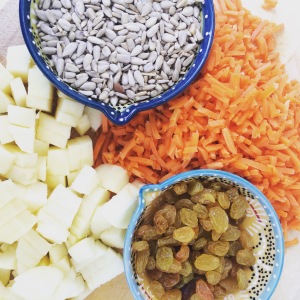
1 1/2 cups grated carrots
2 apples, peeled and diced
1/2 cup golden raisins
1 cup brown sugar
3/4 cup milk (cow, almond or soy)
2 eggs, beaten
1 tsp vanilla
Hemp or sunflower seeds (for muffin tops)
Combine dry ingredients. Combine milk, eggs, sugar and vanilla. Pour liquid into dry. Mix until moistened (don’t over-mix). Fold in carrots, fruits, and nuts.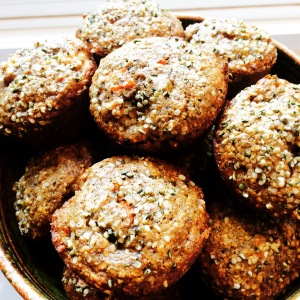
Fill greased muffin tins to about 3/4 of the way then sprinkle with 1/2 tsp hemp or sunflower seeds. Bake at 350 for 12-15 mins. Smother with butter and enjoy!
If nutrition is your thing then read this: good source of fiber, vitamin A, thiamin, manganese, and omega-3s.
1 muffin = 203 kcals, 9g fat, 8g sugar, 5g fiber, 6g protein.

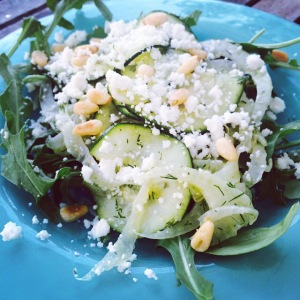

 Make sure you are getting enough carbohydrates as well as enough calories. Calorie deficits create cravings for fast energy sources (sugar!). It is very common to under-nourish yourself just enough to NOT lose significant weight but instead instigate late evening carb cravings due to lack of sufficient calories. Fueling yourself with plenty of HEALTHY carb calories from whole fruits, vegetables, whole grains and beans will keep sugar cravings at bay.
Make sure you are getting enough carbohydrates as well as enough calories. Calorie deficits create cravings for fast energy sources (sugar!). It is very common to under-nourish yourself just enough to NOT lose significant weight but instead instigate late evening carb cravings due to lack of sufficient calories. Fueling yourself with plenty of HEALTHY carb calories from whole fruits, vegetables, whole grains and beans will keep sugar cravings at bay.


